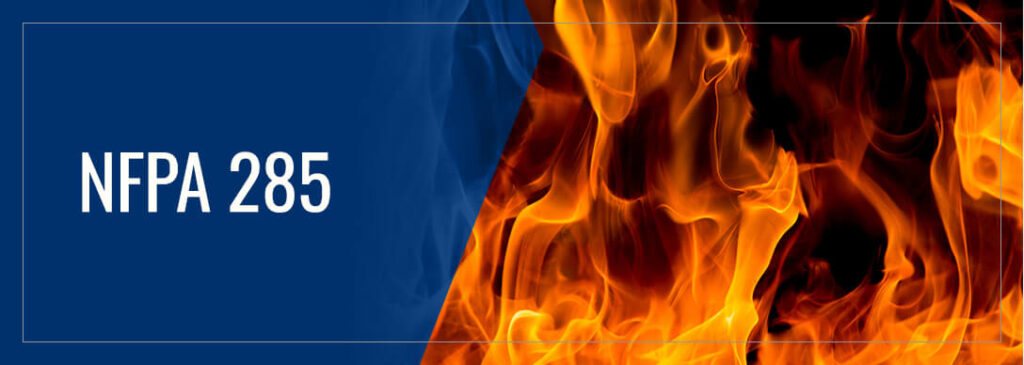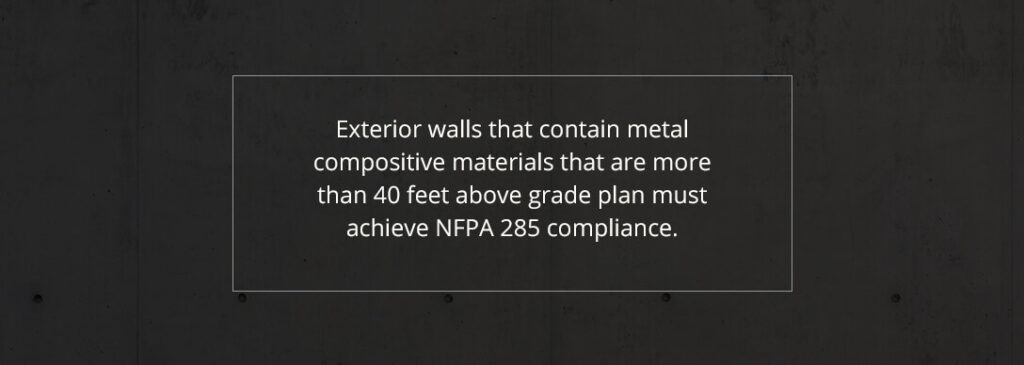NFPA 285 Testing Information

Building regulations and codes exist to keep people safe. Poor building practices put occupants at risk and can turn small issues into massive emergencies. By following the right building codes and passing certain tests, you can ensure your building is as safe as possible.
One of the main dangers that buildings face is fire. Fire can decimate a building and put people’s lives at risk. You must build your building in such a way that fires can be reduced and slowed to ensure people can get out and the fire remains localized for as long as possible. To achieve these outcomes, your building must meet the NFPA 285 requirements.
What Is the NFPA 285 Test?
The National Fire Protection Association (NFPA) has established NFPA 285 as the Standard Fire Test Method for Evaluation of Fire Propagation Characteristics of Exterior Wall Assemblies Containing Combustible Components. The test’s goal is to obtain a better understanding of how fire will spread on an exterior wall should a fire occur.
First published in 1998, the NFPA 285 test is now in its fifth edition for 2023. Yet the true origins of the NFPA 285 test date back to the 1970s after plastic insulation grew in popularity for improving the energy conservation of exterior walls. The Society of Plastics Industry developed a flammability characteristic test for exterior walls, which the Uniform Building Code (UBC) adopted in 1988 under the title UBC 26-4 for measuring horizontal and vertical flame spread on exterior walls that used foam plastic insulation.
After 10 years had passed, the NFPA released the first edition of NFPA 285, which was the same as the slightly adjusted version of the UBC 26-4, called UBC 26-9. The main difference between the original NFPA 285 and the UBC 26-4 was the removal of the non-load-bearing restriction. This allows for the testing of load-bearing walls, although the test does not require that a live load be applied during the test.
NFPA 285 Test Criteria
There are several nuances to the NFPA testing method, with some variations including the thickness of wall components and the materials used in exterior wall assemblies. To find the most detailed list of criteria in the NFPA 285 Test, you can review Section 10.2 of the latest edition of NFPA 285 from 2023.
Here is a general breakdown of the NFPA 285 test criteria:
- Flame propagation on the exterior face of the wall assembly: This includes less than 10 feet of vertical flame spread above the window opening, less than 5 feet of lateral flame spread from the centerline of the window opening and a temperature lower than 1,000 degrees Fahrenheit 10 feet above the window opening.
- Flame propagation through combustible components and insulation: This includes various temperature requirements depending on the used materials in the exterior wall assembly. There are limitations on temperatures within exterior wall panels that contain combustible components and within air cavities between the actual wall and the exterior wall panels, both laterally and vertically.
- Temperatures in the second story: The second story room’s temperatures must stay at or below 500 degrees Fahrenheit above the temperature recorded at the beginning of the test. This temperature is measured one inch from the wall assembly’s interior side.
- Flame propagation to the second story: Flames must avoid spreading to the inside of the second-story room.
- Flame propagation to adjacent horizontal spaces: Flames must avoid horizontal spreading beyond the side walls measured in the test.
When Is the NFPA 285 Test Compliance Required?
These are the various triggers that require NFPA 28 compliance in buildings of Type I, II, III and IV construction:
- Water-resistive barriers: Exterior walls greater than 40 feet above the grade plane that contain water-resistive barriers must comply with NFPA 285. There are two exceptions to this rule. The first is when the wall contains coverings of steel, stucco, terra cotta, concrete or brick meeting the thickness requirements, and the water-resistive barrier is the exterior wall’s only combustible component. The second exception is when the water-resistive barrier is the only combustible component while meeting various ASTM E1354 and ASTM E84 requirements.

- Metal composite materials: Exterior walls that contain metal compositive materials that are more than 40 feet above grade plan must achieve NFPA 285 compliance. Some exceptions exist depending on the area of wall that the metal panels cover and how high the panels are.
- High-pressure laminates: Exterior walls that contain high-pressure laminates must achieve NFPA 285 compliance, except for two exceptions when the installation of high-pressure laminates is at 40 feet or less above the grade plane. These exceptions are when the fire separation distance is five feet or less and the high-pressure laminate’s area does not exceed 10% of the exterior wall surface area, as well as when the separation distance is greater than five feet.
- Mechanical equipment screens: NFPA 285 compliance is one way to be up to code when using screens of combustible mechanical components on roof decks. Two other methods exist.
- Foam plastic insulation: Exterior walls that contain foam plastic insulation must achieve NFPA 285 compliance, with some exceptions.
- Fireblocking: When the exterior wall covering is NFPA 285-compliant, fireblocking is not required.
NFPA 285 Assemblies
It’s important to note the difference between a wall assembly and a wall component as defined by NFPA 285. NFPA 285 is concerned with wall assemblies as a whole. This is the entire wall being tested. Components refer to the individual pieces that make up the wall. NFPA 285 does not test individual components for fire propagation. Rather, NFPA 285 tests the whole exterior wall assembly for standard compliance, with each wall component making up the exterior wall being tested.
NFPA 285 vs. ASTM E119
ASTM E119 is the test most commonly used for wall assemblies to achieve fire-resistance ratings, and it differs from NFPA 285. If your wall can have a fire-resistance rating, then you must test it per ASTM E119. But having a fire-resistance rating per ASTM E119 does not guarantee NFPA 285 compliance. Likewise, walls can comply with NFPA 285 while lacking a fire-resistance rating according to ASTM E119. You must achieve ASTM E119 fire-resistance rating and NFPA 285 compliance separately.

Contact VTEC for Testing
VTEC Laboratories is here to help you with your testing needs. We offer various materials testing and thermal analysis services when you need to make sure your building is following all necessary regulations. Our test methods comply with all official testing requirements to ensure accurate results and your utmost satisfaction.
Even though we do not offer NFPA 285 testing, we invite you to contact us today to take the next step toward your other building testing needs.
